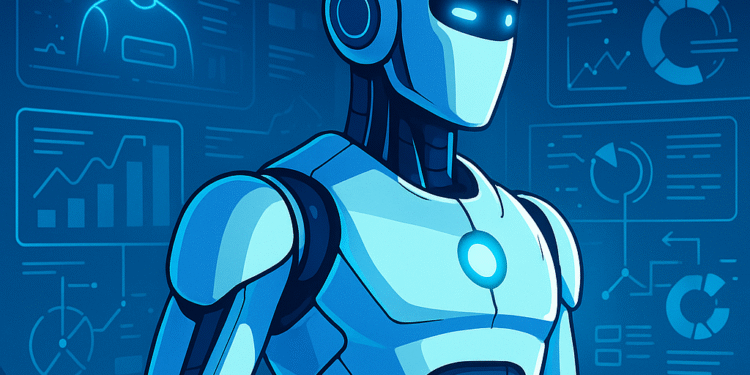
Struggling to keep up with fast-changing business needs? Agentic AI, powered by autonomous AI agents, is transforming how companies work. These advanced enterprise AI solutions handle complex tasks and make decisions without constant human input.
Agentic AI in business isn’t the future—it’s happening now. Keep reading to see what’s next!
Key Takeaways
- Agentic AI in 2025 uses autonomous agents to handle complex tasks, make decisions without human input, and adapt quickly. Examples include Kognitos reducing manual labor by 97% and OnTrac improving customer service with automated agents.
- Large Language Models (LLMs) like GPT-4 power these systems. They analyze data, predict outcomes, and boost decision-making in areas like supply chain automation and IT incident response.
- Multi-agent systems improve teamwork by assigning specialized tasks to different agents. These setups increase scalability, efficiency, and resilience across industries like retail, finance, healthcare, and manufacturing.
- Challenges of agentic AI adoption include explainability issues (black-box behavior), data privacy risks under laws like GDPR/CCPA, bias from flawed datasets, and integration problems with legacy IT systems.
- Best practices for using agentic AI involve setting clear goals, starting small projects first before scaling up, providing employee training programs on the new tech tools while ensuring strong security measures are implemented at every stage.
Key Features of Agentic AI in 2025

Agentic AI makes split-second decisions without waiting for human input. It handles tough tasks, adapts quickly, and works like a tireless assistant in busy workflows.
Autonomous decision-making capabilities
AI agents in 2025 will make decisions without waiting for human input. They analyze real-time data, predict outcomes, and act based on predefined goals. Large Language Models (LLMs) like GPT-4 enhance their reasoning by offering context-rich suggestions.
These systems adapt quickly using machine learning algorithms and reinforcement learning to fine-tune decisions over time.
Multi-agent systems collaborate better than single-agent setups. For example, one agent might manage inventory while another forecasts demand, ensuring smooth supply chain operations.
This teamwork boosts scalability and reduces errors during complex tasks while staying resilient against unexpected challenges or failures.
Goal-oriented behavior in complex workflows
Agentic AI thrives in managing complex workflows by focusing on clear goals. It doesn’t just follow scripts; it adapts to changes and drives results. For instance, supply chain optimization benefits greatly from this approach.
Autonomous agents analyze inventory levels, shipping delays, and demand surges in real-time. They then make decisions to meet specific targets like reducing costs or improving delivery speed.
Large Language Models (LLMs), such as GPT-4, boost this goal-oriented behavior with advanced decision-making skills. These models process massive amounts of data to spot patterns or predict outcomes fast.
For example, Kognitos ensures tasks like multi-step software testing flow without errors caused by misunderstandings or “hallucinations.” This precision helps businesses save time while keeping operations resilient under pressure.
“Efficiency isn’t about doing less; it’s about doing the right things faster.”
Agentic AI vs. Traditional Automation
Traditional automation sticks to scripts, repeating tasks without thinking. Agentic AI, though, acts like a wise assistant—it adapts, learns, and makes smart calls on its own.
How agentic AI surpasses legacy systems
Agentic AI acts with autonomy, making decisions without waiting for human commands. Legacy systems rely on predefined workflows and rigid rules. This limits flexibility in unpredictable scenarios.
Agentic AI analyzes data in real-time, adjusts its actions, and solves problems instantly. For example, it can optimize supply chain management by rerouting shipments when delays occur or resources run low.
Unlike older models that simply follow programmed instructions, agentic AI focuses on achieving specific goals within complex workflows. It uses natural language processing to understand tasks better and adapts as conditions change.
These advanced capabilities allow businesses to improve operational efficiency while reducing bottlenecks across systems like customer relationship management (CRM) or enterprise resource planning (ERP).
Core Use Cases of Agentic AI in Business Operations
Agentic AI handles tricky tasks like a pro, boosting business performance and saving time—keep reading to see it in action!
Supply chain optimization
Dynamic Workflow Agents now analyze real-time data to improve logistics and supply chain management. They streamline workflows, predict demand changes, and reduce inventory waste through machine learning algorithms.
These AI-powered agents make quick decisions based on live updates from suppliers, warehouses, and retail outlets.
Companies use predictive analytics to avoid overstocking or running out of products. For example, advanced AI tools adjust delivery schedules to match shifting market demands. By 2025, this technology will cut operational costs while increasing reliability across global supply chains.
AI bridges gaps in logistics by turning delays into opportunities for smarter processes.
Financial services automation
AI agents now handle complex financial tasks with ease. They analyze market trends and improve client relationships by serving precise insights. Insurance claims are processed faster, cutting errors and saving time for customers.
Kognitos achieved a 97% drop in manual labor costs while operating ten times quicker than before.
These systems also improve fraud detection, ensuring higher accuracy in identifying threats or anomalies. Automation reduces delays across banking operations like loan approval workflows or payment processing.
As a result, businesses save money and boost productivity while offering better services to clients.
Retail workflow enhancement
Retail operations are changing fast. Dynamic Workflow Agents now run tasks like managing inventory, pricing, and checkout processes. These agents build retail workflows on their own, reducing human effort.
They adapt quickly to last-minute updates, boosting efficiency during high-demand periods.
User Assistant Agents also help employees with daily jobs. From checking stock levels to answering customer queries instantly, they make work easier and faster. This automation cuts errors while keeping shelves stocked and customers happy.
Supply chain optimization comes next in improving business flow seamlessly.
The Role of Large Language Models (LLMs) in Agentic AI
Large Language Models (LLMs) like GPT-4 power the brains of Agentic AI. They process and understand natural language, enabling agents to interact fluently with humans. LLMs don’t just respond; they analyze complex tasks, break them down, and provide smart solutions.
For example, in supply chain automation, an agent can suggest ways to reduce delays by consulting data patterns through LLMs.
These models fuel decision-making by drawing insights from vast datasets. Continuous learning allows them to adapt quickly as conditions shift. This means better financial predictions or faster inventory adjustments during demand spikes.
With their machine learning backbone, LLM-powered agents act smarter every day and contribute directly to business growth goals.
Agentic AI in Enterprise IT Systems
Agentic AI automates IT tasks, speeding up reactions to system issues. It simplifies complex workflows, making processes faster and smarter.
Incident response automation
AI agents now handle incident response faster than ever. They detect issues, analyze threats, and deploy fixes without waiting for human input. This reduces delays, protects systems better, and prevents downtime.
Businesses save money while improving security.
OnTrac shows how this works in action. Their AI-powered automation streamlined operations by cutting down reliance on live staff for repetitive tasks. IT teams now focus on bigger priorities instead of putting out fires all day.
Positive impacts like these pave the way for smarter continuous integration workflows ahead.
Continuous integration and testing workflows
Agentic AI reshapes software testing with tools like UiPath’s Test Cloud, Agent Builder, and Autopilot. These systems manage repetitive tasks, catch bugs early, and improve workflows.
Enterprises like Adobe see up to 80% auto-resolution rates through these intelligent agents, as Rahul Guha of Aisera highlights.
These AI-powered solutions streamline integration cycles by running ongoing checks in real time. Applications get tested faster with fewer errors slipping through the cracks. Businesses save time and money while boosting efficiency across their operations.
Real-World Examples of Agentic AI Applications
Businesses now rely on smart AI agents to solve problems faster and reduce manual work. These systems handle tasks like managing customer chats or improving software quality without constant human input.
Case study: AI-driven code quality management
AI agents now transform software development. Tools like Kognitos automate code reviews and reduce manual errors. These agents check for coding standards, improving quality without needing constant human oversight.
They address common issues, like “hallucinations,” by following structured workflows to avoid mistakes.
Kognitos combines multiple steps into one smooth process. This reduces technical debt often seen in outdated systems. Their clients report better efficiency with lower operational costs.
By managing tasks through a unified system, businesses save time while keeping code clean and reliable.
Case study: Automated customer service agents
OnTrac faced rising expenses due to growing customer inquiries. The mounting volume overwhelmed their live agents, causing delays and frustration for users. By deploying automated customer service agents, they streamlined operations and improved outcomes.
These AI-powered tools provided 24/7 support, tackling complex questions with precision while reducing human workload.
Costs dropped while productivity soared. Live agents shifted focus to more strategic tasks that drive long-term success. Customer interactions became smoother and more personalized, boosting satisfaction levels significantly.
This shift also built resilience into workflows, ensuring adaptability during demand spikes or unexpected challenges in operations.
Benefits of Agentic AI in Business Operations
Agentic AI improves how businesses run daily tasks, making them faster and smoother. It also helps teams adapt quickly when plans or challenges change.
Enhanced efficiency and reduced operational costs
Businesses are cutting costs fast with AI task automation. Kognitos, for example, slashed manual labor expenses by 97%. Operations now run ten times quicker, delivering value at lightning speed.
Generative AI adoption is surging too; a McKinsey survey found 65% of companies already using it by 2023.
AI-powered decision making transforms supply chains and workflows. Companies save millions while boosting speed and accuracy. Digital agents work around the clock without breaks or errors.
Efficiency gains pave the way for advanced use cases across industries like IT systems and financial services automation.
Improved adaptability and resilience in workflows
Agentic AI makes workflows smarter and faster. Machine learning algorithms allow systems to learn from past actions, improving each step in real time. This continuous growth helps businesses handle sudden changes or challenges.
Multi-agent systems (MAS) add another layer of strength. They use multiple agents working together on complex tasks like inventory management or financial processes. These agents share work, solve problems quickly, and adapt if one fails, ensuring smooth operations under pressure.
A company like OnTrac shows how such solutions boost output while reducing downtime risks.
Challenges and Risks of Adopting Agentic AI
Adopting agentic AI carries risks that businesses must tackle head-on. One major issue is explainability. Many AI systems act like black boxes, making decisions without clear reasoning.
This lack of transparency can hurt trust and lead to compliance concerns in industries like finance or healthcare. Bias also poses a threat if flawed training data leads agents to make unfair choices, such as favoring one group over another.
Data privacy remains critical too; companies handling sensitive customer data risk breaches or misuse if safeguards fail.
Integration gets tricky for enterprise IT systems full of legacy software and databases. Compatibility problems often slow deployment and increase costs. Balancing autonomy with oversight adds further strain—how much freedom should these agents have? Poor regulation could spark ethical issues, with agents causing harm by prioritizing efficiency over human well-being.
Continuous monitoring and validation are not optional but necessary steps to catch mistakes early, protect security, and keep workflows compliant under evolving global laws like GDPR or CCPA.
Best Practices for Implementing Agentic AI Solutions
Agentic AI can transform businesses, but planning is key. Follow these steps for a smooth and effective implementation.
- Define clear business goals for AI adoption. Identify specific areas where agentic AI can deliver value, like supply chain automation or customer service.
- Start small with pilot projects. Test solutions in controlled environments before scaling across the enterprise.
- Assess processes and data impacted by the change. Map current workflows to understand where agentic AI fits best.
- Promote collaboration between teams and experts. Involve IT, operations, and external AI specialists to align efforts and strategies.
- Educate employees on how agentic AI works. Create training programs to build confidence in using new systems effectively.
- Use advanced models for precision in tasks. For example, employ custom machine learning models for financial audits or code testing workflows.
- Monitor system performance consistently after deployment. Track metrics like efficiency gains, error rates, and cost reductions regularly.
- Build solid security frameworks around AI systems to prevent cyberattacks or data breaches during operations.
- Foster a culture of ongoing learning among staff and leaders alike. Stay updated on advancing technologies and trends within the tech landscape like AI-powered business automation tools.
- Roll out changes gradually while collecting feedback at every stage from users to refine processes further if needed without disrupting existing operations fully upfront!
Future Trends in Agentic AI for Business
Agentic AI will integrate real and simulated data, making predictions sharper and decisions faster. Multi-agent systems will spread across industries, reshaping how businesses manage tasks.
Integration of synthetic and real-world data
Blending synthetic and real-world data creates stronger AI. Synthetic data solves problems like privacy risks, limited datasets, and bias. For example, it generates varied training sets without exposing personal information.
This mix gives AI models more diversity and lessens inaccurate patterns often seen in skewed datasets.
Real-world input adds depth by anchoring learning in actual scenarios. Together, these data types improve machine learning systems’ accuracy and adaptability over time. Businesses using such combinations see better forecasts in supply chain automation or enhanced decision-making across operations.
This integration drives smarter workflows while respecting user safety and fairness rules.
Expansion of multi-agent systems across industries
Multi-agent systems (MAS) are shaking up industries. These systems use multiple AI agents working together to handle tasks that once seemed too complex. They bring scalability, specialization, and resilience to workflows.
For example, retail companies deploy MAS for supply chain optimization, automating inventory tracking and delivery schedules with precision.
In software development, MAS improve code quality by automating reviews and enforcing standards. Financial services also benefit as these agents detect fraud faster than traditional methods.
Industries like healthcare and manufacturing are adopting MAS to streamline processes while reducing errors. Their growth shows no signs of slowing down in 2025.
Conclusion
Agentic AI is not just a trend; it’s shaping how businesses operate. These systems handle tasks smarter and faster, making companies more agile. With tools like dynamic workflow agents and enterprise platforms, businesses are seeing real change.
The future belongs to those who embrace this tech early. Agentic AI isn’t waiting—neither should you!
FAQs
1. What is agentic AI, and how is it different from traditional chatbots?
Agentic AI goes beyond simple conversational tools like chatbots. It uses advanced machine learning to perform complex tasks, optimize workflows, and act as autonomous digital workers in business operations.
2. How are companies using agentic AI for supply chain automation?
Businesses use agentic AI to streamline supply chains by automating inventory management, tracking shipments with data-driven insights, and predicting demand patterns for better planning.
3. Will agentic AI replace traditional enterprise software by 2025?
Gartner’s tech trends predict that while agentic AI will transform many processes, it will likely enhance rather than fully replace traditional business software systems.
4. What are some real-world examples of autonomous agents in businesses today?
Examples include intelligent task automation tools for workforce management, generative AI agents optimizing customer relationships, and recommendation systems improving product offerings based on user behavior.
5. What benefits can companies expect from deploying agentic AI across their systems?
Agentic AI improves efficiency through process automation, reduces errors via pattern detection algorithms, enhances decision-making with simulations or data analysis tools, and optimizes enterprise workflows overall.
6. Are there risks tied to adopting agentic AI in business operations?
Yes; challenges like governance issues around access controls or vulnerabilities in cloud platforms must be addressed carefully during development cycles to protect sensitive information while ensuring seamless integration into existing systems.



















































